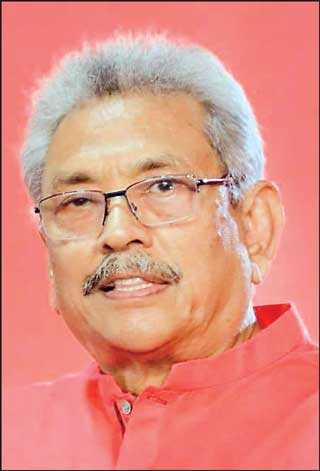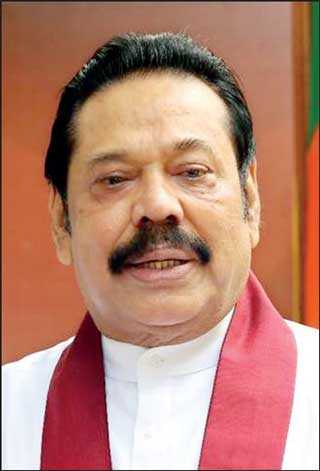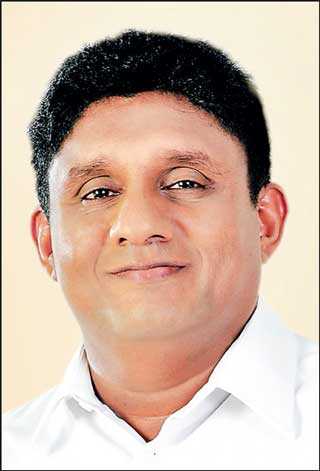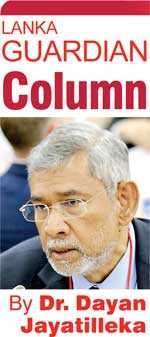Tuesday Nov 18, 2025
Tuesday Nov 18, 2025
Thursday, 12 March 2020 00:00 - - {{hitsCtrl.values.hits}}
Politics in Sri Lanka is becoming triangular and potentially tripolar. The three angles of the triangle are nationalism, neoliberalism and populism; or neoconservatism, neoliberalism and moderate progressivism; or Alt-Right, Old Right and Progressive (Social) Democrat.
 |
Just as the Wickremesinghe Prime Ministership, his CFA with Prabhakaran and unilateral military retrenchment of 2001-2003 guaranteed Mahinda’s candidacy and victory, the Wickremesinghe Prime Ministership of 2015-2019 triggered the tectonic shift in Sinhala society which yielded the Gotabaya Rajapaksa candidacy and victory |
 |
No Sri Lankan government can be stable or even tenable if it hasn’t won and cannot win a majority of the Sinhala majority. Though Mahinda lost, it was his retention of the support of the majority of the Sinhala majority that enabled his swift comeback, the Opposition’s rapid turnaround and facilitated the GR victory |
 |
Even the Easter massacre was thought by Ranil to leave him politically unscathed to such a degree that he attempted to convince his party that he was the strongest Presidential candidate against the Sinhala nationalist tide carrying GR forward |
 |
Sajith Premadasa was the closest approximation to a pluralist populism and the sole chance of pulling off a ‘Black Swan’ event as did Ranasinghe Premadasa in 1988. The youthful challenger fought an intrepid battle against impossible odds and a formidable opponent who had been gifted a head start by the UNP leader |
One must avoid the tautology that Sri Lanka’s traditional two-party system is in crisis because of the crisis in the two traditional parties. It is in crisis—and those two parties are in crisis—because the competitive two-party system was distorted by the dysfunctional experiment in bipartisan coalition government, driven and dominated by neoliberalism. The result of that neoliberal experiment has been the disintegration of the traditional democratic parties, and the flooding of the democratic and (imminently) the constitutional and legal order by the high tide of Sinhala Buddhist
nationalism.
The democratic system in Sri Lanka is now–hopefully momentarily, transitionally—without a moderate centre. Unless the emergent New Opposition thwarts a two-thirds majority, Sri Lanka which had the first stable two-party system in South Asia, will develop a regime-type of dark hybridity. One strand will be the ‘one-party dominant’ model that existed in India from 1947-1977, albeit with a difference—it will be as if the Hindutva religio-nationalists rather than the secular Congress had been that party. The other strand will be the tight system, heavily military-bureaucratic, that Pakistan had until Imran Khan impacted, and Bangladesh experienced under the presidencies of Ziaur Rahman and Mohamed Ershad. The state will be a silo for weaponised majoritarian political nationalism.
Having lost elections repeatedly at the hands of one dominant global trend, resurgent (majoritarian) nationalism, it was inevitable that the UNP’s neoliberal elite establishment, representing as it does a declining global trend, would be challenged from within by the other ascendant global trend, Populism.
In a globalised world, even anti-(neoliberal) globalism gets globalised. The international trends were bound to impact us. Despite the evidence, the UNP dominated administration of former Prime Minister Wickremesinghe and his chief ideologue, Mangala Samaraweera pushed an agenda and an ideology which had been and was being rejected, from the USA to the Philippines, from Britain to Brazil.
This impacted on a huge hollow hidden just beneath the surface of the Samaraweera political strategy (spelled out in a Sunday Times article in late 2014) of a majority of the minorities and a minority of the majority. That had produced an electoral win for the Yahapalanaya coalition but foredoomed the Yahapalanaya government. Politics is not merely about the ephemeral arithmetical acquisition but also the stable retention of political power.
No Sri Lankan government can be stable or even tenable if it hasn’t won and cannot win a majority of the Sinhala majority. Though Mahinda lost, it was his retention of the support of the majority of the Sinhala majority that enabled his swift comeback, the Opposition’s rapid turnaround and facilitated the GR victory. Ranil and Mangala’s neoliberalism fatally dissolved the slice of Sinhala support that Yahapalanaya subsisted on in the Southern two-thirds of the island.
1956 reloaded
The international trends apart, there were powerful and obvious national patterns and precedents. In 1956, in what became the template for the recent success of the JO-Mahinda comeback-SLPP-GR project, the fathers of Ranil Wickremesinghe and Mangala Samaraweera were on opposite sides.
While Mahanama Samaraweera was an SLFP stalwart, Esmond Wickremesinghe was advisor to Sir John Kotelawala, a UNP Prime Minister. The pro-West foreign policy posture of Sir John and Esmond in Bandung when postcolonial nationalism was sweeping Asia and Africa, fed into voter antipathy and nationalist triumph. Sir John Kotelawala was reviled as “Bandung Booruwa” (the Bandung donkey) for his pro-Westernism in 1956. More crucial were a sociocultural backlash against what was perceived as a decadent life style and a tilt to the minorities (the Delft speech).
The island’s two leading neoliberals, Ranil and Mangala were on opposite sides of the conflagration that almost consumed the democratic system and the UNP in the late 1980s. As Prime Minister R. Premadasa constantly cautioned at the time, the crisis was created by an economic model which widened socioeconomic inequity at an accelerated pace, and rendered inflammable by foreign intrusion. Democracy and the UNP were saved from painful extinction by fielding the patriotic populist Ranasinghe Premadasa as the UNP candidate at the 1988 Presidential election.
Under Yahapalanaya, Prime Minister Ranil Wickremesinghe and Minister Mangala Samaraweera shifted back to West-centrism, deracination and foreignisation, beginning with disparaging remarks made to the media during a Ministerial briefing at the Sri Lankan Embassy in Beijing about alleged corrupt business practices of the host country’s development projects in Sri Lanka (which possibly cost the Minister his portfolio, and the country, Hambantota) right up to the ‘Sir John’ type tweet against the Buddhist clergy and a promise to sign the controversial MCC agreement in the midst of Presidential candidate Sajith Premadasa’s election campaign. 
As if the red lights weren’t sufficiently glaring, there was also the negative political experience of 2001-2003. Prime Minister Ranil Wickremasinghe had won the parliamentary election in 2001, his first since he took over the leadership in 1995, and promptly kicked-off a combination of neoliberal economic shock therapy and Chamberlainesque appeasement of the separatist-terrorist Tigers.
President Kumaratunga sacked him in late 2003 and he launched a protest campaign rather like the one that restored him to office in November 2018 when President Sirisena felt similarly compelled to replace him. The difference was that President Kumaratunga had the executive prerogative of calling a snap election, a constitutional capacity removed by the 19th amendment. The electorate showed a complete lack of solidarity with the ousted PM, and the UNP lost the parliamentary election of 2004, setting the stage for defeat at the hands of Mahinda Rajapaksa in 2005.
Sinking the SLFP
After 2001, Ranil’s UNP would take almost 15 years to win again, in August 2015, having fielded breakaway SLFP General Secretary Maithripala Sirisena as the UNP-backed presidential candidate in January. As the new PM in 2015 Wickremesinghe promptly repeated the same policies of economic neoliberalism, pro-Westernism and minoritarianism as in 2001-2003, triggering exactly the same outcome of defeat at the 2018 Pradesheeya Sabha elections at the hands of the freshly minted SLPP.
Once in a coalition government, the UNP leadership did not remain prudently within policy parameters that were compatible with the core interests of the SLFP’s moderate leadership and parliamentarians.  Instead of practicing bipartisanship and cementing a moderate-centrist coalition through policy consensus, the UNP leadership attempted a power-grab by presenting a constitutional project that mirrored the authoritarian-personalist 1995 constitution of the UNP itself.
Instead of practicing bipartisanship and cementing a moderate-centrist coalition through policy consensus, the UNP leadership attempted a power-grab by presenting a constitutional project that mirrored the authoritarian-personalist 1995 constitution of the UNP itself.
It should have responsibly and realistically refrained from practices and policies (e.g. bond scam, Geneva 2015, non-unitary ‘orumittanadu’ Constitution, ACSA, SOFA, MCC) which would cause huge dissonance in the base of the moderate nationalist SLFP, thereby weakening Yahapalanaya senior partner President Sirisena and sundering the SLFP itself, with the benefit accruing not to the UNP but to a robustly Sinhala Buddhist nationalist alternative sustained by a matrix of militant political Bhikkhus and temples.
Praetorian nationalism
By coopting the SLFP, the neoliberal project created a political vacuum which was quite naturally filled by a populist-nationalist breakaway from the SLFP, which displaced, overwhelmed and has almost obliterated the latter.
Speaker Karu Jayasuriya stubbornly depriving the numerically much larger JO led by Mahinda Rajapaksa of the role and function of the Opposition in Parliament and substituting instead the much smaller TNA and JVP as the official Opposition, ignited credible Sinhala nationalist fears that the majority community was being politically dispossessed in the only country it can call its own.
This minoritarian political profile and practice, when combined with legislatively debarring a presidential comeback bid by Mahinda Rajapaksa (instead of using the fair qualifier “concurrently”), and the myopic overthrow of the moderate Mahinda-Maithripala equation in Nov 2018 which provided an option for a ‘soft landing’, radically polarised politics and narrowed the candidacy options for change.
The neoliberal political elite was so enthralled by the roll-back of the Maithri-Mahinda ‘soft intervention’ of October-November 2018, that it actually thought a few candlelight vigils, hashtag campaigns, petitions from expatriate academics, and a legal ruling, spoke louder than the electoral earthquake of Feb 2018 which battered both the UNP and the SLFP.
By creating an ethos (as in pre-Putin 1990s Russia) in which defence was downgraded and security practices and apparatuses disaggregated and demoralised, gaps or blockages were created through which the intelligence warnings of the Easter massacre went undelivered and/or unactioned. This narrowed the options, providing a customised opening and irreversible thrust for a hard-edged, Praetorian nationalism.
The UNP leadership’s arrogant neoliberalism has enthroned its antipode. The narrowly legalistic interpretation of the 19th amendment in late 2018 in favour of Ranil’s built-in insurance policy against dismissal by dissolution, has resulted in an overt executive determination to liquidate the 19th amendment–interestingly, without exempting (despite MR’s premiership and the strong SLPP presence) its partial powershift to the PM and the legislature.
The TNA’s disregard of the 13th amendment and duplicitous game of nomenclature with “orumittanadu/ekeeya” in place of “unitary” have created a situation in which the island’s leader declares there is nothing to be politically devolved or negotiated because the Tamil issue is actually economic masked as political.
The Geneva 2015 overcommitment on accountability has caused a discourse backlash in which “the disappeared”, correctly de-limited in the LLRC and Paranagama reports as non-combatant/post-combatant cases, and a residual category warranting independent investigation, are newly conflated with MIAs.
The UNP-TNA attempt at a neoliberal Constitution, absurd given the axiomatic arithmetic, has unleashed its opposite: the arithmetically achievable target of a neoconservative Constitution which will place a hyper-presidency at the pinnacle of an ultra-centralist state with quasi-theocratic norms, and reverse every democratising reform of the state structure and the legal and electoral sub-systems, starting with “revisiting” 13A of 1987. With a two-thirds majority, the State could switch mode, turn dark monolith.
Organic Opposition
The self-destruction of Yahapalanaya and the crisis of the UNP were foretold at the very outset of the 2015 administration in an extraordinarily telling episode. The iconic Prof Joseph Stiglitz, winner of the Nobel Prize for Economics, visited Sri Lanka and was on a panel with Prime Minister Ranil  Wickremesinghe. He expressed very clear views on the economic direction that postwar, post-election Sri Lanka should go, made specific policy recommendations and explicitly cautioned against certain measures.
Wickremesinghe. He expressed very clear views on the economic direction that postwar, post-election Sri Lanka should go, made specific policy recommendations and explicitly cautioned against certain measures.
Upon return to Harvard, Joe Stiglitz wrote it up and posted it on his website. The record shows that the then Prime Minister and two successive Finance Ministers of the UNP not merely ignored the advice but moved in precisely the opposite direction, i.e., the direction that Stiglitz advised against.
It is this misplaced neoliberal arrogance that killed off the Yahapalana experiment and brought the UNP and its estranged coalition partner the SLFP to their present existentially imperilled situation.
Even the Easter massacre was thought by Ranil to leave him politically unscathed to such a degree that he attempted to convince his party that he was the strongest Presidential candidate against the Sinhala nationalist tide carrying GR forward. A brief glance at a world map would have shown that rightwing nationalism could not be deflected and defeated by anything other than a progressive populism, left populism, or left nationalism as in Mexico, Argentina and Nepal (and most recently in Ireland). In New Zealand it took a charismatic social democrat, and in France, a youthful, new, centrist liberalism. Ranil was/is none of the above. Not even close.
Sajith Premadasa was the closest approximation to a pluralist populism and the sole chance of pulling off a ‘Black Swan’ event as did Ranasinghe Premadasa in 1988. The youthful challenger fought an intrepid battle against impossible odds and a formidable opponent who had been gifted a head start by the UNP leader, scoring a 42% which was impressive by any comparative international standard. Ranil, who ducked two Presidential elections (2010, 2015) after he lost two (1999, 2005) and took the UNP down to a historic low in Feb 2018 while PM, doesn’t think that such heroic resistance entitles Sajith to the party leadership.
To be electorally viable the Opposition needs an organic, culturally sensitive and socially responsive national leadership rather than an alienated and permanently alienating one. If not for Sajith’s SJB option, the democratic opposition represented by the UNP would have shrivelled due to voter animus and apathy, guaranteeing the Government a two-thirds majority.
Just as the Wickremesinghe Prime Ministership, his CFA with Prabhakaran and unilateral military retrenchment of 2001-2003 guaranteed Mahinda’s candidacy and victory, the Wickremesinghe Prime Ministership of 2015-2019 triggered the tectonic shift in Sinhala society which yielded the Gotabaya candidacy and victory.
Wickremesinghe’s neoliberalism has been to the pandemic of toxic majoritarian nationalism, what the wet market in Wuhan was to the Coronavirus: the (politico-ideological) disease vector. There is no hope of de-radicalisation and de-toxification of the Sinhala South unless it is deprived of the enemy image and hate symbol that his policies and profile represent. No viable opposition or moderate reformist government is possible when headed by a political personality so easily depicted as ‘The Other’, evoking an image of a proxy of foreign and minority interests existentially threatening to the preponderant Sinhala nation.
So long as a Chamberlain or Petain figure, a political symbol of humiliating wartime appeasement, compounded by massive moral irresponsibility which resulted in resurgent terrorism and the shock of the Easter massacre, remains a permanent fixture and target in Sri Lankan politics, so too does the political grip (as distinct from historical salience) of triumphant ‘Caesarism’ on the Sinhala psyche. This permanentises the potential for the political weaponisation of Sinhala nationalism.
There will always be mistrust of the UNP in particular and an open, pluralist, liberal democracy in general, with Ranil and Ranilism at the helm. Once this factor is politically peripheralised, a different, ‘non-zero sum’ future can be envisaged over time, as allergies recede and memories fade. In Sri Lanka, liberal democracy is viable only as populist social democracy; interethnic reconciliation is possible only within an overarching patriotism, a national democracy.
A clear majority of UNP legislators led by the party’s only presidential candidate in 1½ decades and the only son of the last elected UNP leader of the country, formed the SJB to get out from under the electorally crushing deadweight of the sarcophagus that is the Old Guard leadership.
The UNP under Ranil is way more than uncompetitive; it simply cannot survive on an electoral grid structured and traversed by majoritarian nationalism. The democratic Opposition must be able to win (back) a majority of the Sinhala majority someday, and Sajith is its sole chance of so doing. A neo-Gramscian reading suggests that only a moderate patriotic discourse, at the core of which is a social democratic, reformist nationalism representing the enlightened, rational, open, humanistic, universalist “soft power” latent/potential within Sinhala Buddhist society and culture, can appeal to the public imagination, inform and guide a competitive Opposition, and later, even the Sri Lankan nation, at this stage of history and social consciousness.